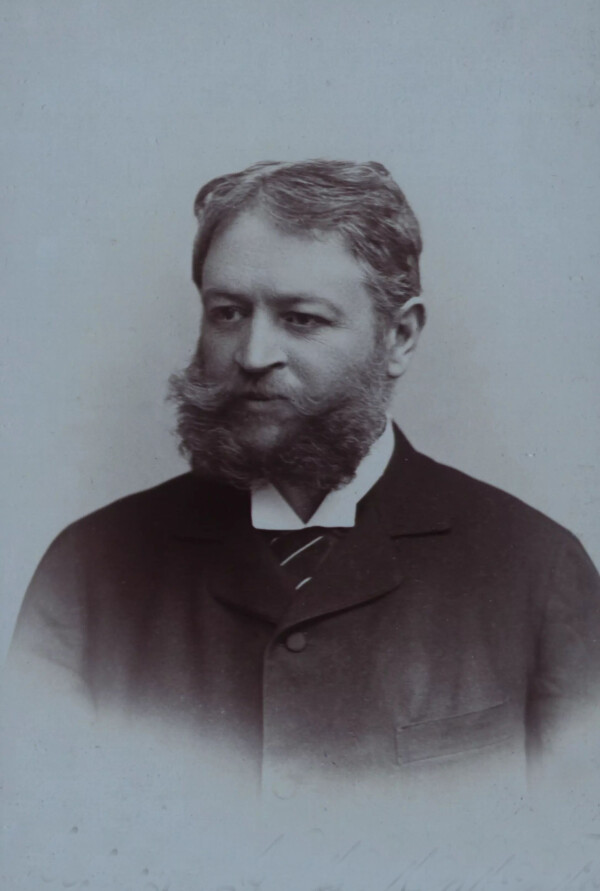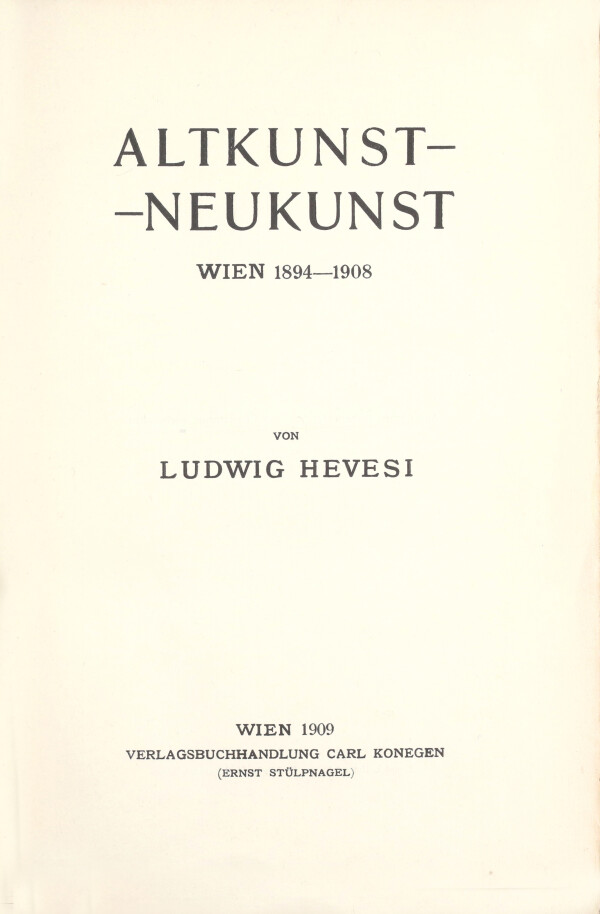Ludwig Hevesi

Ludwig Hevesi photographed by Josef Löwy, 1905, Wien Museum
© Wien Museum

Ludwig Hevesi: Altkunst – Neukunst, Vienna 1909.
© Klimt Foundation, Vienna
Hevesi was an author, art critic, humorist, travel writer and writer of books for young people. As a pioneer of Modernism and one of the most important chroniclers of Vienna’s art scene around 1900, Hevesi supported the Secession and Gustav Klimt’s work.
Ludwig Hevesi, born as Ludwig Hirsch (Hungarian name: Lajos Lövy), was the son of the assimilated Jewish doctor Mór Lövy and his wife Adél. He was born in Heves, Hungary, on 20 December 1843. He saw education as his ticket out of the province and spoke several languages at an early age. He attended the Piarist School in Budapest and went on to study medicine and classical philology in Budapest and Vienna. He financed his studies by working as a translator and journalist. Eventually, he discontinued his studies and decided to turn his sideline activities into a professional career.
He worked for the daily newspaper Pester Lloyd in Budapest as early as 1866. Around 1872, he began using the pen name Ludwig Hevesi. In 1875, he took an editorial job with the daily Fremdenblatt. He pursued an extensive representation of Vienna’s artistic and cultural scene in his professional activities over the following 35 years, gaining renown especially for his art reviews. He wrote for more than 20 newspapers and magazines during his lifetime, including continual contributions to the Secession’s official magazine Ver Sacrum from its first issue. He also wrote for the Zeitschrift für bildende Kunst and the Breslauer Zeitung.
Art Reviews, the Secession and Gustav Klimt
Hevesi is considered a trailblazer of modern art and an ardent supporter of Gustav Klimt.
The art critic himself recalls in his preface to Berta Zuckerkandl’s Zeitkunst, published in 1908, that he was present when the group surrounding Gustav Klimt, Carl Moll and Hermann Bahr first had the idea to found the Secession at a gathering at the Zuckerkandls’ salon. Furthermore, it was Hevesi who came up with the association’s motto “To every age its art. To art its freedom,” which decorates the Secession building in golden letters to this day. Consequently, Hevesi was aptly dubbed the “inspirator” of Austrian Modernism.
He published favorable reviews of the Secession’s exhibitions and explicitly welcomed the association’s decision to include art from other countries. Hevesi perceived himself as an advocate of Modernism and considered his work a means to enlighten and educate the public. In this context, he published the work Österreichische Kunst im 19. Jahrhundert in 1903.
He gathered his many articles and feuilleton pieces in several collections. The volume Acht Jahre Secession, published in 1906, is valuable for its detailed descriptions of several paintings by Klimt which are now lost or presumed lost or which survive only in black-and-white reproductions. Hevesi was among those contemporaries who recognized the revolutionary significance of Klimt’s art and he assigned an adequate place to the artist’s works in the art of Vienna around 1900. Carl Moll even thanked Hevesi for his extraordinary understanding of Klimt’s oeuvre, presumably in the context of a review of the “Klimt Collective Exhibition”:
“Finally, I can read in print that there is somebody in Vienna who truly feels our Klimt – truly understands and appreciates him. My heartfelt thanks for your masterful words on our Viennese ‘pride.’”
Hevesi greatly admired the Faculty Paintings and defended Klimt’s compositions, reprimanding the critics:
“One good thing has come of the professors’ protest. It has made Klimt’s ‘Philosophy’ famous. It is now one of the most famous works in Austrian art history, which is why the university should be glad to have it in its auditorium.”
He also questioned the understanding of art among those who criticized Klimt and demanded that the topic of art be restored to the artists.
Advocate of Modernism
Even after the Klimt Group left the Secession, Hevesi remained loyal to Gustav Klimt’s circle. He focused on promoting the artists of the Kunstschau and the Vereinigung der ganz Freien. He was one of only very few critics who recognized Oskar Kokoschka as a rising young talent at the “1908 Kunstschau Wien.” As an untiring supporter of modernism, he wrote the book Altkunst Neukunst in 1909.
Furthermore, his exhibition reviews helped increase the renown of the Miethke Gallery. In 1912, the gallery presented Hevesi’s own art collection – which for instance included drawings by Klimt – together with that of Richard Muther.
In addition to his activities in the field of fine arts, Hevesi also worked as a theater critic, for instance reviewing performances at the Vienna Burgtheater, and published travel books as well as popular humorist feuilleton pieces. Moreover, he is considered the first important collector of utopian novels in Europe.
Hevesi never married and committed suicide at his Vienna apartment at the age of 66 on 27 February 1910.
Literature and sources
- Österreichisches Biographisches Lexikon. Hevesi Ludwig. www.biographien.ac.at/oebl/oebl_H/Hevesi_Ludwig_1842_1910.xml (04/14/2020).
- Wien Geschichte Wiki. Ludwig Hevesi. www.geschichtewiki.wien.gv.at/Ludwig_Hevesi (04/14/2020).
- Wiener Zeitung. www.wienerzeitung.at/nachrichten/zeitreisen/799093-Ein-Vorkaempfer-fuer-Gustav-Klimt.html (04/14/2020).
- Ludwig Hevesi: Für Klimt, in: Acht Jahre Sezession (März 1897–Juni 1905). Kritik – Polemik – Chronik, Vienna 1906, S. 245- 249, S. 246 – 247.
- K-B: Selbstmord des Schriftstellers Hevesi, in: Grazer Tagblatt, 28.02.1910, S. 3.
- Ludwig Hevesi: Secession. Frühjahrsausstellung, in: Acht Jahre Sezession (März 1897–Juni 1905). Kritik – Polemik – Chronik, Vienna 1906, S. 232-238, S. 233, S. 370-375, S. 371.

